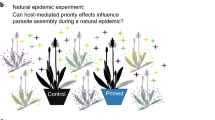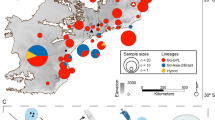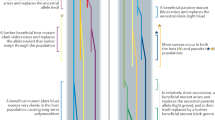Abstract
According to the Red Queen hypothesis—which states that interactions among species (such as hosts and parasites) lead to constant natural selection for adaptation and counter-adaptation—the disproportionate evolutionary success of parasites on common host genotypes leads to correlated selection for sexual reproduction1,2,3,4,5,6,7,8 and local adaptation by the parasite population9,10,11,12,13,14. Here we determined whether local adaptation is due to disproportionate infection of common host genotypes, and, if so, whether infection of common host genotypes is due to commonness per se, or some other aspect of these genotypes. In a reciprocal cross-inoculation experiment parasites occupying the same geographical area (sympatric) infected locally common host genotypes significantly more often than rare host genotypes, whereas parasites occupying separate geographical areas (allopatric) showed no such significant difference. A mixed source of parasites (containing F1 hybrids) also showed no difference in infection between rare and common host genotypes. These results show that local adaptation results from parasite tracking of locally common host genotypes, and, as such, a necessary condition of the Red Queen hypothesis is met.
This is a preview of subscription content, access via your institution
Access options
Subscribe to this journal
Receive 51 print issues and online access
$199.00 per year
only $3.90 per issue
Buy this article
- Purchase on Springer Link
- Instant access to full article PDF
Prices may be subject to local taxes which are calculated during checkout


Similar content being viewed by others
References
Jaenike, J. An hypothesis to account for the maintenance of sex within populations. Evol. Theor. 3,191–194 (1978).
Bremermann, H. J. Sex and polymorphism as strategies in host–pathogen interactions. J. Theor. Biol. 87, 671–702 (1980).
Hamilton, W. D. Sex versus non-sex versus parasite. Oikos 35, 282–290 (1980).
Seger, J. & Hamilton, W. D. in The Evolution of Sex (eds Michod, R. E. & Levin, B. R.) 176–193 (Sinauer and Associates, Sunderland, 1988).
Nee, S. Antagonistic coevolution and the evolution of genotype randomization. J. Theor. Biol. 140, 499–518 ( 1989).
Hamilton, W. D., Axelrod, R. & Tanese, R. Sexual reproduction as an adaptation to resist parasites (A review). Proc. Natl Acad. Sci. USA 87, 3566–3573 (1990).
Howard, R. S. & Lively, C. M. Parasitism, mutation accumulation and the maintenance of sex. Nature 367, 554–557 (1994).
Peters, A. D. & Lively, C. M. The Red Queen and fluctuating epistasis: a population genetic analysis of antagonistic coevolution. Am. Nat. 154, 393–405 ( 1999).
Judson, O. P. Preserving genes: a model of the maintenance of genetic variation in a metapopulation under frequency-dependent selection. Genetic. Res. 65, 175–191 (1995).
Gandon, S., Capoweiz, Y., Dubois, Y., Michalakis, Y. & Olivieri, I. Local adaptation and gene-for-gene coevolution in a metapopulation model. Proc. R. Soc. B 263, 1003–1009 (1996).
Lively, C. M. Migration, virulence, and the geographic mosaic of adaptation by parasites. Am. Nat. 153, S34–S47 (1999).
Parker, M. Local population differentiation for compatibility in an annual legume and its host-specific fungal pathogen. Evolution 39, 713–723 (1985).
Lively, C. M. Adaptation by a parasitic trematode to local populations of its host. Evolution 46, 1663–1671 (1989).
Ebert, D. Virulence and local adaptation of a horizontally transmitted parasite. Science 256, 1084–1086 ( 1994).
Dybdahl, M. D. & Lively, C. M. Diverse, endemic and polyphyletic clones in mixed populations of the freshwater snail Potamopyrgus antipodarum. J. Evol. Biol. 8, 385– 398 (1995).
Dybdahl, M. F. & Lively, C. M. Host–parasite coevolution: evidence for rare advantage and time-lagged selection in a natural population. Evolution 52, 1057– 1066 (1998).
Dybdahl, M. F. & Lively, C. M. The geography of coevolution: comparative population structures for a snail and its trematode parasite. Evolution 50, 2264– 2275 (1996).
Norusis, M. J. SPSS Advanced Statistics User's Guide (SPSS, Chicago, 1990).
Acknowledgements
We thank L. Delph for helpful comments on the manuscript. This study was supported by the US National Science Foundation.
Author information
Authors and Affiliations
Corresponding authors
Rights and permissions
About this article
Cite this article
Lively, C., Dybdahl, M. Parasite adaptation to locally common host genotypes. Nature 405, 679–681 (2000). https://doi.org/10.1038/35015069
Received:
Accepted:
Issue Date:
DOI: https://doi.org/10.1038/35015069
This article is cited by
-
Genotypic and morphological diversity of trematodes Leucochloridium paradoxum
Parasitology Research (2023)
-
The functional ecology of four invasive Ponto–Caspian gobies
Reviews in Fish Biology and Fisheries (2023)
-
New monogeneans from the bathydemersal southern African endemic catshark, Holohalaelurus regani (Gilchrist, 1922)
Systematic Parasitology (2021)
-
Patterns of ectoparasite infection in wild-caught and laboratory-bred cichlid fish, and their hybrids, implicate extrinsic rather than intrinsic causes of species differences in infection
Hydrobiologia (2021)
-
Ascarid infection in wild Amur tigers (Panthera tigris altaica) in China
BMC Veterinary Research (2020)
Comments
By submitting a comment you agree to abide by our Terms and Community Guidelines. If you find something abusive or that does not comply with our terms or guidelines please flag it as inappropriate.



